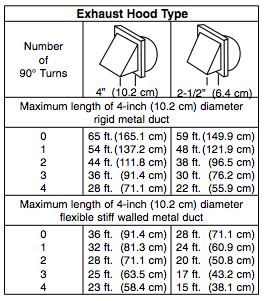| Author |
Message |
    
local denizen
Citizen
Username: Local_denizen
Post Number: 87
Registered: 8-2004
| | Posted on Saturday, April 8, 2006 - 1:52 am: | 



|
My dryer vents to the front side of my house and has a disastrous effect on nearby plants and shrubs. I'd like to leave the dryer where it is but have the air exit to the side of the house.
Can I extend it for a longish run outside of the house? If the answer is "no" I guess it's really "no" for inside the house too, right?
Any other solutions? |
    
Bailey
Citizen
Username: Baileymac
Post Number: 223
Registered: 3-2005
| | Posted on Saturday, April 8, 2006 - 8:04 am: | 



|
This is from Maytag's website, you can maybe download the installation manual for your machine.
 |
    
Robert O'Connor
Citizen
Username: Local24
Post Number: 8
Registered: 3-2006
| | Posted on Saturday, April 8, 2006 - 1:05 pm: | 



|
Local denizen,
According to the 2003 International Mechanical Code, Section 504.6.1 Maximum lenght. The maximum lenght of a clothes dryer exhaust duct shall not exceed 25 ft. (7620mm) from the dryer location to the outlet terminal. The maximum lenght of duct shall be reduced 2 1/2 feet for each 45-degree (0.79rad) bend and 5 feet (1524 mm) for each 90-degree (1.6 rad) bend. The maximum lenght of the exhaust duct does not include the transition duct.
Exception: Where the make and model of the clothes dryer to be installed is known and the manufacturer's installation instructions for such dryer are provided to the code official, the maximum lenght of the exhaust duct, including any transition duct, shall be permitted to be in accordance with the dryer manufacturer's installation instructions. |
    
local denizen
Citizen
Username: Local_denizen
Post Number: 88
Registered: 8-2004
| | Posted on Saturday, April 8, 2006 - 1:54 pm: | 



|
Thanks for the info. Interesting that the code info is much more conservative than Maytag's. But I see if I use rigid ducting I can really increase the length. This just might work after all... |
    
jeb
Citizen
Username: Jeb
Post Number: 109
Registered: 9-2001
| | Posted on Saturday, April 8, 2006 - 3:28 pm: | 



|
local d,
if using sheetmetal duct do not use sheet metal screws to connect the sections. the dryer debri can get caught on the screws and potential problems may ensue. rather, use the aluminum or mastic tape. |
    
Robert O'Connor
Citizen
Username: Local24
Post Number: 9
Registered: 3-2006
| | Posted on Saturday, April 8, 2006 - 4:37 pm: | 



|
Local denizen,
The maximum exhaust duct lenght of 25 feet is the normal installation requirement for domestic clothes dryers. The 25-foot limit is based on the worst case scenario where the dryer is rated for a maximum duct lenght of 25-feet. The exception to the code section referenced allows longer exhaust duct lenghts when the manufacturer's instructions specify the additional lenght. The make and model of the dryer must be provided to the code official, along with the installation instructions, to permit the code official to inspect the duct installation based on the manufacturer's instructions.
If the exception to the code section (referenced above) is used, the inspector must verify that the specific make and model dryer is installed before final approval can be given.
A point to consider is the situation that will exist when you move and the new owners don't install a dryer that allows the longer duct lenght. If the duct is not marked conspicuosly, the new owners will be unaware of the potentially hazardous situation that has been created by the dryer and exhaust mismatch.
Each change in direction increases the duct's resistance to air flow. The lower the velocity will allow lint particles in the dryer exhaust to drop out of the airstream and collect in the duct. As the lint builds up in the duct, the efficiency of the dryer will be reduced and eventually the volume of lint will become a potential fire hazard.
Because of poor planning, dryers are often installed in locations that require excessively long duct runs, often with multible changes in direction. Whether the distance is 25-feet or some distance specified by the manufacturer, duct bends (fittings) will sigificantly reduce the allowable lenght and must be accounted for in the installation and at the time of inspection. It is not un-common to find installations that cannot comply with the code. In those cases, the dryer must be relocated or a condensing (ductless) dryer must be used.
Another opinion is clothes dryer booster fans, which would have to be approved by the inspector in your town, because the code does not have an allowance for them. The code does not currently address booster fans because the dryers are not listed for use with booster fans, booster fans do not currently interlock with the dryer to prevent dryer operation in the event of booster fan failure and booster fans will likely be installed in locations where the building owner/occupant will not be aware of the fan and its opreational condition.
I did not mean to become loooong winded with this post but I find too often people make silly mistakes when installing gas fired equipment and it unfortunatly leads to tragic results.
Good Luck! |
    
local denizen
Citizen
Username: Local_denizen
Post Number: 89
Registered: 8-2004
| | Posted on Saturday, April 8, 2006 - 11:55 pm: | 



|
Bravo, Robert, your explanation makes a ton of sense. I really appreciate it.
And thanks also jeb and bailey, I've got a lot of good info to work with now. |